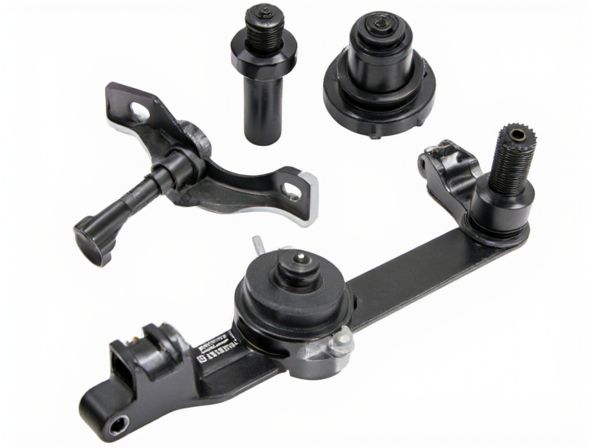
Photo illustration: Camber Plate vs Fixed Top Mount
Camber plates offer adjustability for your vehicle's suspension alignment, allowing precise tuning of camber angles to improve handling and tire wear. Fixed top mounts provide a sturdy and straightforward setup with no adjustments, ensuring consistent performance and durability. Choosing between the two depends on whether you prioritize customizable suspension settings or a more reliable, maintenance-free installation.
Table of Comparison
| Feature | Camber Plate | Fixed Top Mount |
|---|---|---|
| Adjustability | Allows adjustable camber settings for precise suspension tuning | Fixed camber angle with no adjustability |
| Ride Comfort | Maintains factory ride quality with minor changes | Can be stiffer, reducing ride comfort |
| Performance | Improves handling and cornering with camber adjustment | Limited handling improvement due to fixed alignment |
| Installation | Requires precise alignment and occasional adjustments | Simple bolt-on installation |
| Durability | High-quality materials, may wear over time due to moving parts | More durable with fewer moving components |
| Cost | Higher upfront cost due to complexity | More affordable option |
| Ideal Use | Track use, performance tuning, and aggressive driving | Daily driving and mild suspension upgrades |
Introduction to Camber Plates and Fixed Top Mounts
Camber plates are adjustable suspension components designed to modify the camber angle of a vehicle's wheels, improving handling and tire contact during cornering. Fixed top mounts, in contrast, offer a rigid attachment point for the suspension strut with a preset camber angle, prioritizing durability and alignment stability. These components play crucial roles in suspension tuning, with camber plates providing flexibility and fixed mounts ensuring structural integrity.
What Are Camber Plates?
Camber plates are adjustable suspension components installed at the top of a vehicle's strut assembly, allowing drivers to fine-tune the camber angle of the front wheels for improved handling and tire wear. These plates offer greater alignment flexibility compared to fixed top mounts, enabling precise adjustments that enhance cornering grip and overall vehicle stability. Unlike fixed top mounts, camber plates provide dynamic control, making them essential for performance tuning and motorsport applications.
What Are Fixed Top Mounts?
Fixed top mounts are suspension components designed to attach the vehicle's strut directly to the chassis without any rotational adjustability, providing a solid and stable connection that improves handling precision. Unlike camber plates, which offer adjustable angles for fine-tuning wheel alignment and stance, fixed top mounts maintain a set position, enhancing durability and reducing suspension noise. These mounts are commonly used in performance street and racing applications where consistent suspension geometry and feedback are essential.
Key Differences Between Camber Plates and Fixed Top Mounts
Camber plates allow adjustable camber angles, enhancing vehicle alignment and cornering performance, while fixed top mounts provide a static setup with limited adjustability. Camber plates typically offer improved handling precision by enabling fine-tuning of suspension geometry, whereas fixed top mounts deliver durability and simplicity with less maintenance. The choice impacts ride quality and suspension responsiveness, making camber plates ideal for performance tuning and fixed top mounts suitable for reliable, everyday driving.
Performance Impact: Camber Plates vs Fixed Top Mounts
Camber plates allow for adjustable camber settings, enhancing cornering grip and tire contact patch optimization, which improves overall handling performance on varied track conditions. Fixed top mounts offer more rigidity and consistent alignment, contributing to better steering feedback and stability, but lack the flexibility to fine-tune suspension geometry for specific driving styles. Choosing between camber plates and fixed top mounts directly impacts suspension tuning, influencing ride quality, responsiveness, and tire wear patterns.
Adjustability: Benefits and Limitations
Camber plates offer superior adjustability by allowing precise changes to the camber angle, enhancing tire contact and handling performance, especially in track and performance driving. Fixed top mounts provide a rigid connection with minimal or no camber adjustment, prioritizing durability and stability over customization. While camber plates enable fine-tuning for specific driving conditions, fixed mounts offer simplicity and reduced maintenance without sacrificing baseline suspension alignment.
Installation Process Comparison
Camber plates offer a more adjustable installation process, allowing precise camber angle tuning through bolts and an eccentric mechanism designed for quick alignment changes. Fixed top mounts require a straightforward installation with fewer components but lack the flexibility to adjust camber angles without additional suspension modifications. The camber plate system is ideal for enthusiasts seeking fine-tuned suspension performance, while fixed top mounts appeal to users prioritizing simplicity and structural rigidity.
Cost Considerations and Value
Camber plates typically cost more upfront than fixed top mounts due to their adjustable design, allowing precise alignment and improved handling performance. Fixed top mounts are generally less expensive and simpler, offering durability but limited adjustability, making them suitable for cost-sensitive builds. Investing in camber plates can enhance suspension tuning and tire wear management, potentially providing better long-term value for performance-oriented drivers.
Best Applications for Each Option
Camber plates provide adjustable alignment settings, making them ideal for performance vehicles and track racing where precise camber tuning improves cornering and tire wear. Fixed top mounts offer increased rigidity and straightforward installation, best suited for daily-driven cars or vehicles prioritizing durability and suspension stability over adjustability. Choosing camber plates benefits enthusiasts seeking customizable handling, while fixed mounts are preferred for consistent, maintenance-free suspension performance.
Which Should You Choose: Camber Plates or Fixed Top Mounts?
Camber plates offer adjustable suspension geometry, allowing precise alignment tuning for improved handling and tire wear, making them ideal for performance enthusiasts and track use. Fixed top mounts provide a simpler, more durable solution with less complexity and maintenance, suited for daily drivers seeking reliability over customization. Choose camber plates for flexibility and enhanced cornering control, or fixed top mounts for cost-effective stability and straightforward installation.
 caratoz.com
caratoz.com